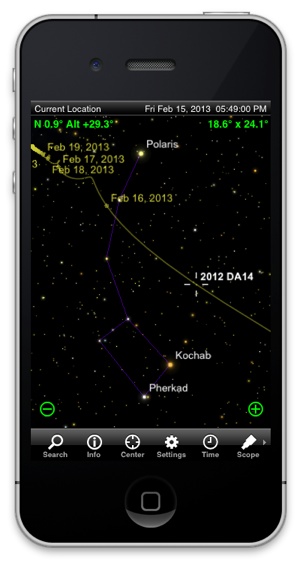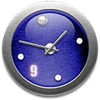This Friday, Feb. 15, a 180,000-ton asteroid dubbed “2012 DA14” will fly past the Earth. And you can follow it with Apple devices.
Whizzing by just 17,200 miles away, this 50-meter space rock will come closer than our orbiting geosynchronous communication satellites. Although there is no chance of a collision, this passage of 2012 DA14 by the Earth is a record close approach for an object of this size.
To let you track 2012 DA14, Southern Stars is releasing an update to its SkySafari Plus and Pro apps for iOS, Mac OS X, and Android. These app updates are a new first in mobile computing, and a solution to an unusual technical challenge, according to Southern Stars founder Tim DeBenedictis. Because the Earth’s gravity affects the asteroid’s orbit so severely, most desktop planetarium programs — and all other mobile apps — will completely fail to predict the asteroid’s position correctly, he adds.
To solve this problem, Southern Stars consulted with solar system dynamics experts at NASA’s Jet Propulsion Laboratory. With JPL’s help, SkySafari has become the first mobile app with a full-blown solar system orbit integrator built in.
“We’re not just playing back the NASA video,” DeBenedictis explains. “The iPhone is actually doing the math live in real time.”
The asteroid will not be visible to the naked eye, but amateur astronomers with larger backyard telescopes should be able to catch a glimpse through clear, dark skies. SkySafari Plus and Pro were the first mobile apps to offer built-in telescope control, using Southern Stars’s wireless SkyFi device or via SkyWire, the first Apple-approved serial cable for iOS devices.
Southern Stars will offer the new app updates to SkySafari Plus and Pro on the Apple App Store, the Mac App Store, and Google Play with sale prices up to 30% off. The sale begins Feb. 14 and will continue through Sunday, Feb. 17. The updates will be free for current SkySafari Plus and Pro owners.
Amateur astronomers wanting to observe the 2012 DA14 flyby with SkySafari should consider the Pro version, because its much larger star database will make it far easier to find the faint asteroid moving across background star fields, says DeBenedictis. But either the Plus or Pro version will simulate the asteroid’s flyby accurately, as seen from any place on Earth — or look back on Earth from 2012 DA14 itself, he adds. To download SkySafari Plus, use the following links:
° iOS (sale price USD $9.99, regularly $14.99): https://itunes.apple.com/us/app/skysafari-3-plus/id437111155?mt=8
° Mac OS X (sale price USD $14.99, regularly $19.99): https://itunes.apple.com/us/app/skysafari-plus/id451902629?mt=12
° Android (sale price USD $9.99, regularly $14.99): https://play.google.com/store/apps/details?id=com.southernstars.skysafari_plus
To download SkySafari Pro, use the following links:
° iOS (sale price USD $29.99, regularly $39.99): https://itunes.apple.com/us/app/skysafari-3-pro/id437112382?mt=8
° Mac OS X (sale price USD $39.99, regularly $49.99): http://www.southernstars.com/products/skysafari_mac/download.html
° Android (sale price USD $29.99, regularly $39.99): https://play.google.com/store/apps/details?id=com.southernstars.skysafari_pro
Note that the basic version of SkySafari doesn’t support the new asteroid/comet orbit integrator. This new feature is exclusive to SkySafari Plus and Pro.





